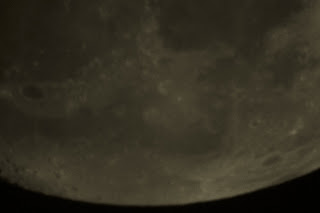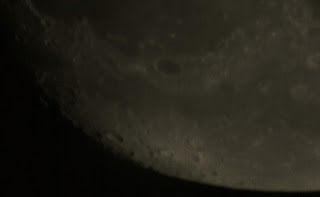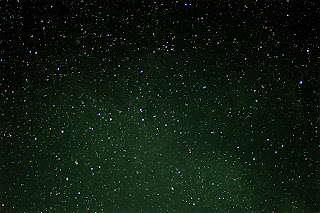May 31st 0500 GMT Moon and Sun
I woke up to clear sky. I snapped the Moon low in the south
with my DSLR at 300mm focal length, ISO 400 and 1/500 second exposure.
I added a solar filter and reset the ISO setting to 100 then
snapped the Sun.
May 29th 0505 GMT Sun
May 27th 0840 GMT Sun
There was a lot of moving cloud. I snapped the Sun with my DSLR and filter at my usual settings. I didn't nail focus and the stack didn't work
May 25th 1200 GMT Sun
The Sun was quiet and I took several shots with my DSLR and Mak at my usual settings. Unfortunately, the stack did not work, so I processed a single frame.
May 20th 2035 GMT Moon
I photographed the Moon with my DSLR at 300mm focal length,
ISO 100 and 1/500 second exposure.
May 20th 1815 GMT Sun
I took a quick Sun shot through my DSLR and filter at 300mm focal length, ISO 100 and 1/500 second exposure. As it turned out, it was my best and most detailed image of the Sun, using this method.
May 19th 1930 GMT Moon
I did an extensive Moon shoot, firstly full disc with my Mak and DSLR at 1.54m focal length, ISO 100 and 1/500 second exposure.
I then took some regional shots at 4.62m focal length, ISO 100 and 1/50 second exposure. Unfortunately, the stacks did not work, so these are all single images.
May 19th 0805 GMT Sun
I took some full disc snaps of the Sun with my Mak and DSLR
at 1.54m focal length, ISO 100 and 1/500 second exposure.
May 17th 2155 GMT Moon
Conditions were hazy, with few stars visible. I snapped the Moon with my DSLR at 300mm focal length, ISO 100 and 1/500 second exposure.
May 14th 1935 GMT Moon
I snapped the Moon with my DSLR at 300mm focal length, ISO 100 and 1/400 second exposure.
May 12th 1000 GMT Sun
I took a sneaky break from gardening and took some full disc
snaps of the Sun with my Mak and DSLR at my usual settings.
May 11th 1045 GMT Sun
It was still rather hazy, which also meant we missed the northern lights the night before.
I took a set of full-disc solar shot with my Mak and DSLR at my usual settings of 1.54m focal length, ISO 100 and 1/500 second exposure.
May 10th 2030 GMT Moon
Conditions were somewhat hazy but the thin crescent Moon
hung low in the west above the houses. I photographed it with my DSLR camera at
300mm focal length, ISO 100 and 1/200 second exposure.
May 9th 2030 GMT Moon
Conditions were somewhat hazy but the thin crescent Moon
hung low in the west above the houses. I photographed it with my DSLR camera at
300mm focal length, ISO 100 and 1/200 second exposure.
May 9th 1135 GMT
Sun
The Sun seemed very active, even through binoculars and I
made this sketch.
May 7th 1615 GMT Sun
I caught a pause in the cloud to photograph the Sun with my
Mak and DSLR at 1.54m focal length, ISO 100 and 1/500 second exposure.
May 5th 0000 GMT Star Shoot
It cleared and continued to clear throughout the session but
it was too late to capture the star clusters in Cancer, as they had set.
I set up my DSLR camera at 70mm focal length, ISO 100 and 8
seconds exposure. I took 11 dark frames for processing.
I started with the constellation of Lyra. I took 10 frames and stacked them.
I also processed one of the frames separately, as it contained a meteor trail, caught completely by accident. It was my first one of the year, showing how bad the weather had been.
Then it was the well-known star cluster Melotte 111 in Coma
Berenices. I processed 11 light and 11 dark frames.
I tried for the harder M13 in Hercules. Well, trying was the operative word. I missed them.
Next up was the head of Draco.
I did a widefield shot of the double star Albireo that I had seen in binoculars the night before. I caught it but it was at the top left of the image and not the centre, as I intended.
I moved slightly to the star pattern of the Coathanger. This is well-known amongst astronomers but not to the public. It actually does look like a coathanger but the stars are unrelated to each other and different distances from us. I took another shot, with the Coathanger near the top. Both photos showed a lot of the Milky Way.
I finished with a pot at M39 in Cygnus. It was one that missed by a mile.
It wasn't a totally successful shoot but I caught some objects well.
May 5th 2359 GMT Meteor
While scouting for photographic targets, I saw a meteor
shoot south east through Hercules with a short trail.
May 4th 0950 GMT Sun
For a change, the weather forecast was wrong but in my
favour. Although there was moving cloud, there was enough clear sky to
photograph the Sun with my usual settings with my Mak and DSLR at 1.54m focal
length, ISO 100 and 1/500th second exposure. I grasped my window of
opportunity before it became iconised!
May 4th 2325 GMT Binocular Session
The weather forecast was for clear skies. They didn't happen! I kept checking the sky from 2100 GMT and I could only see a few stars. When I finally decided it had cleared enough, half of the sky, to the north and west was clouded out, with various layers of thin cloud obscuring the east and south. Clearly, any photography was out of the question, without neither Moon nor planets to offer a realistic target.
I took my binoculars out for a look round. I was able to bag
many double stars which are within the range of my binoculars. I saw
Alcor and Mizar in the Plough, Epsilon and Delta Lyrae in the constellation of
Lyra. Cygnus revealed Albireo, one of the best-known double stars to
astronomers. I bagged two double stars in Draco, Nu and 16/17 Draconi.
The only "faint fuzzy" object I could see was the
globular cluster in Hercules known as M13. It is normally an easy
"pot" in my large binoculars but was quite an achievement under the
conditions.
Did I bemoan the lack of photographic opportunities or feel
grateful I could see anything beyond our solar system at all? A bit of both,
probably!
May 2nd Moon Reprocess
May 2024 started as April did , so after posting my April report and, under the cloud, I revisited a Moon photo from October 2004.










































